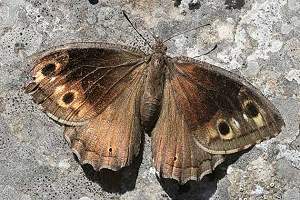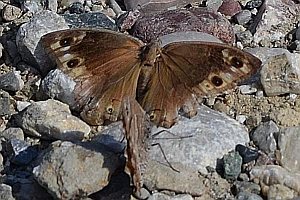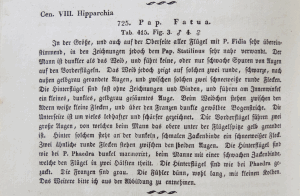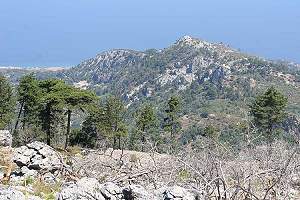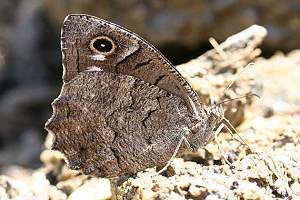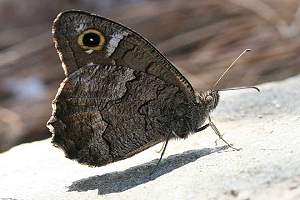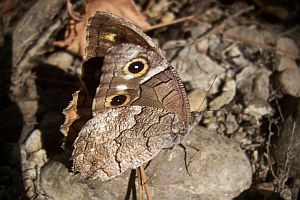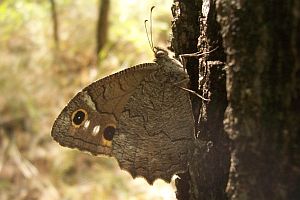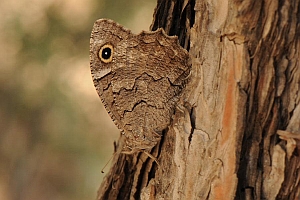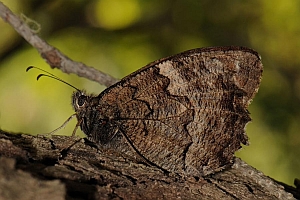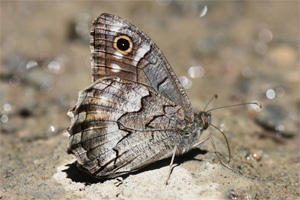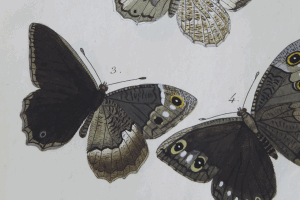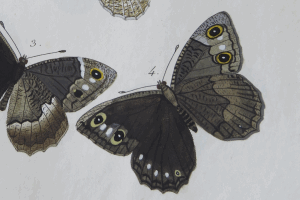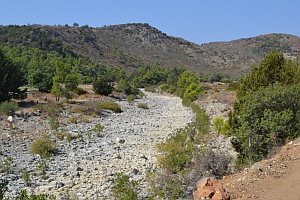

 +14Kontinente:EUAS
+14Kontinente:EUAS1. Lebendfotos
1.1. Falter
1.2. Balz
2. Diagnose
Gegenüberstellung der Merkmale von H. fatua und H. statilinus in einem Forumsbeitrag von Christian Papé: [Ozelle] [Querlinie]
2.1. Erstbeschreibung
3. Biologie
3.1. Habitat
4. Weitere Informationen
4.1. Etymologie (Namenserklärung)
„Frau oder Tochter des Faunus.“
4.2. Synonyme
- Papilio allionii Hübner, 1824
4.3. Nomenklatur
Gemäß Opinion 134 des ICZN (Hemming (1939)) ist Hipparchia fatua als Originalkombination bei Freyer (1843) zu betrachten.
4.4. Taxonomie und Faunistik
Für H. fatua wurden eine Reihe von geographischen Subspecies beschrieben. Rajaei et al. (2023: 223) hatten für den Iran ssp. fatua (ag, as, ar), ssp. persiscana (Verity, 1937) und ssp. dagi Korshunov & Krasilnikova, 1990 (ks, kr) akzeptiert, bemerkten aber: "The status of the subspecies recognized under H. fauta [sic!] needs further study. Records of the taxon sichaea (Lederer, 1857) from Iran refer to H. fatua persiscana." Letztere war die nach ihnen im Iran am weitesten verbreitete Unterart.
Naderi et al. (2025: 373) überraschten mit der Feststellung: "Our DNA analysis and examination of morphological characteristics revealed that populations from central and eastern Zagros were distinct from H. fatua at species level, described here as H. lunulata sp. nov. It seems clear that the range of the new species partially overlaps (at least) with that of H. fatua persiscana in western Iran (provinces of Lorestan and Hamadan), and it is likely that in places where they co-occur, they could also hybridize. Focused sampling in these areas followed by DNA analysis of the samples are required to confirm the existence and/or extent of the hybridization between the two species and clarify the boundaries between these taxa as well as those in Turkey, Iraq and Syria." S. 362 hatten sie festgestellt: "Our specimens from the Zagros mountains (Markazi, Esfahan and Fars provinces) displayed a remarkable genetic (barcode) distance (4.5 ± 0.2 %) from other H. fatua populations, signaling distinction at a species level." Doch sie trennten nicht nur H. lunulata vom Zagros-Gebirge als eigene Art ab, sondern gaben auch Hinweise zur Gliederung der Art im Norden des Iran: "Historically, populations of H. fatua in north- and western Iran have been considered to belong to ssp. persiscana. We found that the populations in central Alborz mountains in north Iran share the same haplotype as those in west and northwest Iran (Ardabil, Azarbaijan Province), even though the latter possess a somewhat darker complexion. The status of populations in Kopet-Dagh mountains (ssp. dagi Korshunov & Kralinikova, 1990), previously synonymized with ssp. persiscana (Nazari 2003, Tshikolovets et al. 2014), remains unconfirmed by molecular means. Westwards, the range of ssp. persiscana extends to the eastern parts of Iranian Kordestan province (Fig. 5); however, our DNA analyses confirmed that samples of H. fatua from the western parts of this province close to the border with Iraq are genetically identical to those in the Levant, i.e. H. fatua sichaea, whose presence in Iran was recently questioned (Rajaei et al. 2023). This finding significantly expands the range of this subspecies from the Mediterranean coasts to the westernmost edges of the Zagros mountains, however, the exact distribution of this subspecies in southern Turkey and northern Iraq remains unclear. Unlike ssp. persiscana that prefers drier habitats, ssp. sichaea flies in river valleys in dense humid oak forests in the Iranian Kordestan, similar to its preferred habitats around Beirut. In addition, it is also possible that the range of the nominotypical ssp. fatua extends to the northwesternmost corner of Iran, however this remains to be confirmed by molecular means." Der Satz "however, our DNA analyses confirmed that samples of H. fatua from the western parts of this province close to the border with Iraq are genetically identical to those in the Levant, i.e. H. fatua sichaea, whose presence in Iran was recently questioned (Rajaei et al. 2023)" ist allerdings in Frage zu stellen, denn die Untersuchung beschränkte sich ja auf Standard-Barcodes der COI-Region und schloss Kern-DNA damit aus. "genetically identical" ist also zumindest reichlich übertrieben, und möglicherweise wurden daraus unzulässige Schlüsse gezogen. Denn selbstverständlich sollte bei Unterarten mit räumlichem und gelegentlich auch tatsächlichem Kontakt auch Einkreuzungen möglich sein, so dass es auch bei Unterarten auch Linien mit dem "falschen" Barcode geben kann. Barcoding ist damit - für sich genommen - keine hilfreiche Methode zur Abgrenzung von Unterarten; hier muß die (Genital-)Morphologie und die Untersuchung von Kern-DNA mit einbezogen werden. Über die Unterarten im Nordwesten des Iran wissen wir also nach wie vor nichts Zuverlässiges.
(Autor: Erwin Rennwald)
4.5. Publikationsjahr der Erstbeschreibung
Wir folgen den Ausführungen von Olivier (2000).
4.6. Literatur
- Erstbeschreibung: Freyer, C. F. (1842-1845): Neuere Beiträge zur Schmetterlingskunde mit Abbildungen nach der Natur 5: 1-166, pl. 385-480. Augsburg (beim Verfasser).
- Hemming, F. (ed.) (1939): Opinion 134. On the method to be adopted in interpreting the Generic Names assigned by Freyer to species described in his Neuere Beiträge zur Schmetterlingskunde, 1833–1858. — Opinions and Declarations rendered by the International Commission on Zoological Nomenclature 2, Section A: 1-6. London.
- Naderi, A., Ten Hagen, W. & V. Nazari (2025): Molecular phylogeny of Hipparchia Fabricius, 1807 (Lepidoptera: Nymphalidae: Satyrinae) with description of an overlooked species from the Zagros mountains, Iran. — Zootaxa, 5636 (2): 361–375. [zum open access-Artikel auf mapress.com]
- Olivier, A. (2000): Christian Friedrich Freyer's „Neuere Beiträge zur Schmetterlingskunde mit Abbildungen nach der Natur“: an analysis, with new data on its publication dates (Insecta, Lepidoptera). — Beiträge zur Entomologie 50 (2): 407-486. Berlin (Wiley-VCH) [PDF auf zobodat.at].
- Rajaei, H. & O. Karsholt (eds.) (2023): Catalogue of the Lepidoptera of Iran. — In: Rajaei, H. & O. Karsholt (eds.) (2023): Lepidoptera Iranica. — Integrative Systematics 6 (Special Issue): 121–459. [Zum PDF auf bioone.org]











